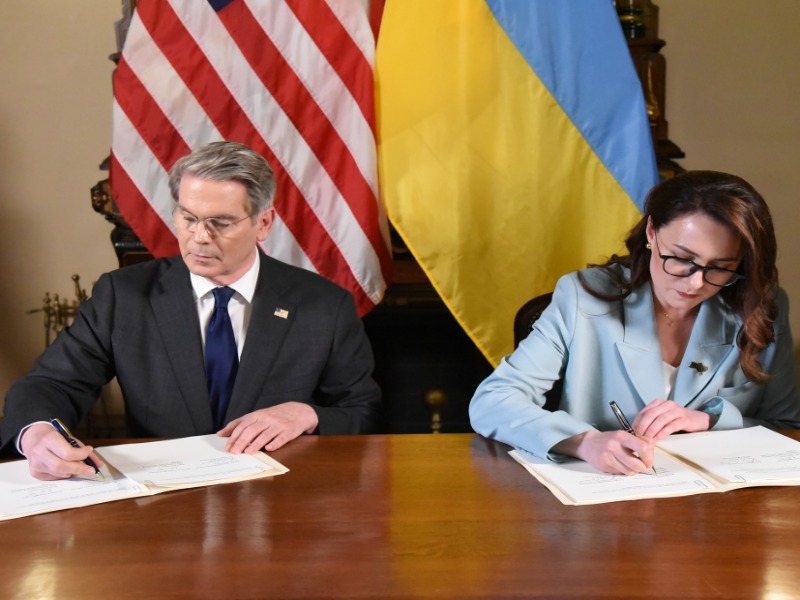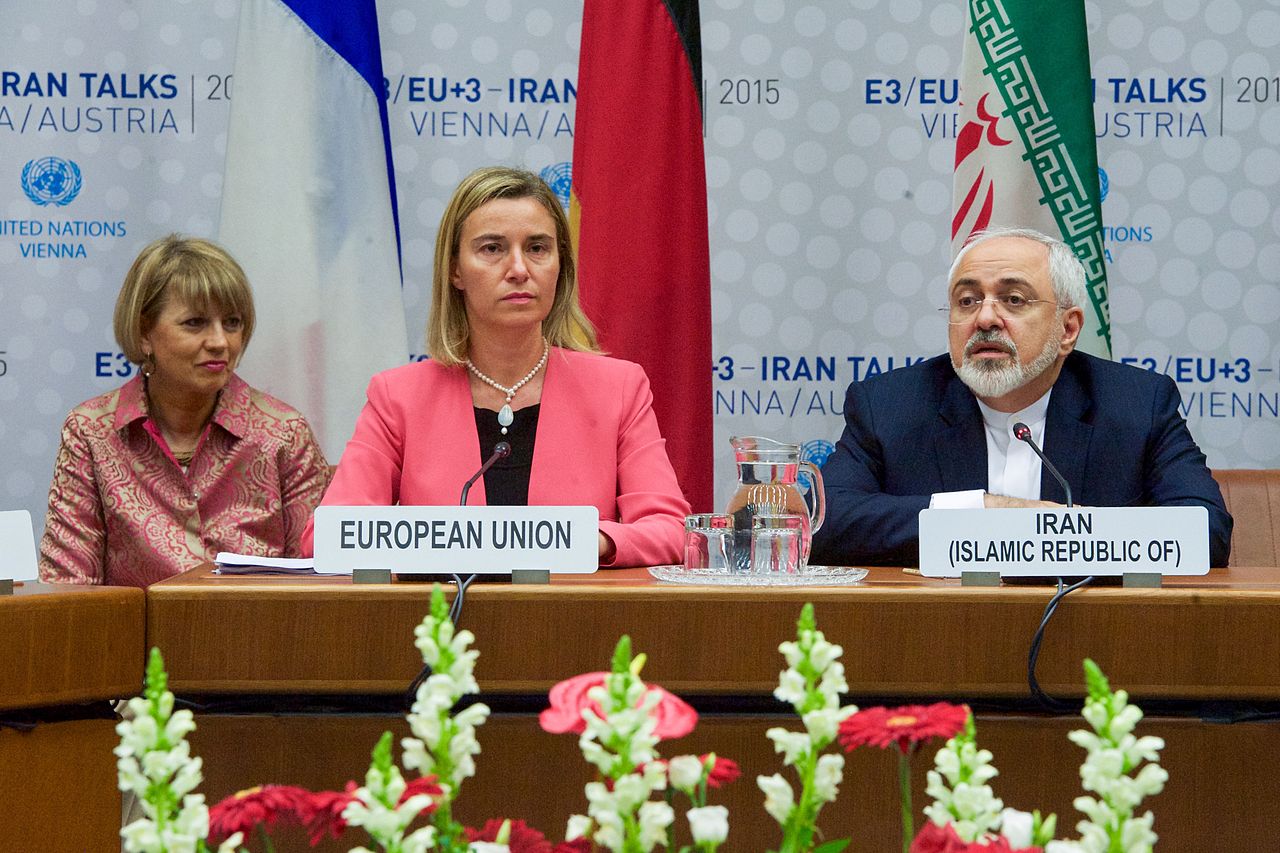On April 30, 2025, U.S. Treasury Secretary Scott Bessent and Ukrainian Vice Prime Minister Yulia Svyrydenko signed the U.S.-Ukraine mineral deal. The agreement came to fruition after months of uncertainty and contestation, exemplified by the heated clash between Trump and Zelenskyy in the Oval Office earlier in February. The U.S. and Ukraine do not share a longstanding history of mineral trade, but both countries have recently prioritized this partnership domain: the U.S. to decrease its supply chain reliance on China, and Ukraine to maintain American war support under Trump. The final version of the deal established the joint reconstruction investment fund, with the profits split equally between the parties. On paper, the agreement is designed to provide Ukraine with capital inflow for the post-war recovery and economic growth while simultaneously giving the U.S. preferential access to Ukraine’s critical natural resources.
The agreement is a diplomatic victory for Ukraine. The country’s negotiating team has managed to craft a forward-looking deal. That is, Ukraine does not need to repay the military support it received from the U.S. since the start of the Russian full-scale invasion – a condition put forward by the Americans during initial negotiations. Ukraine also retains full ownership of its minerals. This contrasts with the previous iterations of the agreement, where the U.S. expressed interest in taking partial or full control of Ukraine’s natural resources and infrastructure. At least on paper, the deal appears collaborative and reciprocal – something many analysts doubted would be the outcome of the negotiating process. It seems that Ukraine avoided earlier predictions of American infringement on the country’s sovereignty, fears over neocolonial resource exploitation, and expectations of reparations.
The agreement is also an expression of the tougher American position on the Russo-Ukrainian war, characterized by condemnation of Russian aggression. Since Donald Trump took office in January 2025, the White House has grown closer to Russia, refusing to assign blame for the invasion and criticizing Ukraine for its lack of desire to establish lasting peace. The mineral deal returns to the language of condemnation and commits the U.S. to rebuilding the extensive damage that Russia inflicted on Ukraine. It also prohibits any entity that sponsored Russia’s war from benefiting from Ukraine’s post-conflict recovery. Hence, the document is at minimum a partial reaffirmation of American alignment with the Euro-Atlantic stance on supporting Ukraine against the Russian war of aggression. Notably, the deal also recognizes Ukraine’s aspirations to join the EU and promises not to conflict with the country’s raw materials agreement with Brussels. This is another sign of American respect for its European allies and their existing partnerships.
While the deal signals that the U.S. is unlikely to fully deviate from its established foreign policy and does not intend to abandon long-standing alliances, American assistance to Ukraine is still not comparable to the degree articulated by the European or Canadian leaders. The main difference remains Washington’s reluctance to provide Ukraine with meaningful security guarantees, as well as its push for expediting peace talks at the expense of Ukraine’s territorial integrity. The agreement is also not a sign of American willingness to engage militarily in Ukraine at the level seen under Biden’s administration. That said, the deal opens the possibility of the U.S.’s long-term involvement in Ukraine’s economic development. To Russia, it demonstrates that Ukraine remains a strategic American ally and that further aggression against Ukraine can be interpreted as an action that jeopardizes American trade interests. This is especially pertinent since one of Ukraine’s largest mineral reserves lies 10 kilometers away from the Pokrovsk frontline. This suggests that the U.S. has economic incentives to prevent further Russian encroachment into Ukraine’s Donbas region.
That said, the economic aspect of the U.S.-Ukraine mineral deal remains ambiguous. Its monetary success hinges on the durability of the ceasefire, as termination of hostilities is key for attracting private investment. However, current peace negotiations show little promise. Russia is not willing to compromise and demands recognition of Ukraine’s occupied territories as its possessions. It is also rejecting Ukraine’s ceasefire proposals and has recently intensified attacks on civilian infrastructure throughout the country. Ukraine, in turn, is not obtaining the security guarantees it seeks from its Western allies to protect itself from further Russian aggression. Given the grim ceasefire prospects, it is unlikely that Ukraine’s economic climate will become conducive to large-scale mining investment anytime soon.
Other inhibitions to the economic prosperity of the deal include a lack of recent geological mapping in Ukraine, which complicates the assessment of potential profits. Approximately half of Ukraine’s power grid has been destroyed by Russia, which will obstruct the energy-intensive mining process. Much of Ukraine’s minerals also lie in the temporarily occupied regions. It is not yet clear who will have de facto control of this territory in the near future. But in any scenario, this land will require a lengthy demining process before any profit-seeking activities can be resumed. Thus, for now, the treaty is a greater manifestation of diplomatic rather than economic success. Despite its potential profitability, the above-listed complications hinder any real investment interest from American mining companies.
This partnership does, however, demonstrate to other NATO members how to use economic incentives to maintain American engagement in the Euro-Atlantic alliance. Ukraine has played the American rush to decrease reliance on Chinese critical minerals to its advantage. Other NATO members, including Canada, can emulate this strategy. Canada has abundant reserves of lithium, graphite, nickel, copper, and cobalt – critical minerals vital to national security and the clean energy transition, whose extraction is currently dominated by China. The Canadian government should invest in the development of mines to create the conditions for negotiating a mutually beneficial trade agreement with the U.S. This could allow Canada to reaffirm its self-sufficiency, which has recently been questioned by the American administration. Unlike Ukraine, Canada’s investment climate faces fewer impediments and is thus more likely to generate immediate business interest.
One challenge for Canada is to ensure that this process does not violate indigenous rights, as much of the country’s critical minerals lie on indigenous lands. Prime Minister Carney has recently pledged that mine developments will not move forward without the informed consent of native populations. However, some indigenous activists voiced concerns that expediting rare earths extraction and ensuring a fair consultation process are contradictory goals and cannot be implemented simultaneously. Mining for critical minerals can also cause large-scale environmental harm, which extends well beyond high energy consumption. It is the government’s responsibility to implement the best existing sustainability practices in the extraction process. For now, it remains unclear whether Canada can fast-track mining operations while simultaneously delivering on promises to indigenous populations and minimizing environmental risks.
Photo: Ukrainian First Deputy Prime Minister Yulia Svyrydenko and U.S. Treasury Secretary Scott Bessent sign a critical minerals agreement between Ukraine and the U.S. in Washington, D.C. on April 30, 2025. Image of the Cabinet of Ministers of Ukraine, accessed via Wikimedia Commons (CC BY 4.0).
Disclaimer: Any views or opinions expressed in articles are solely those of the authors and do not necessarily represent the views of the NATO Association of Canada.





